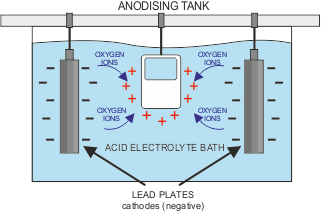
1. To protect them against the elements and resulting corrosion.
2. To increase the aesthetic / visual appeal.
3. To increase or reduce electrical conductivity.
4. To prevent or limit tarnishing of the surface, therefore, no need for repetitive polishing.
5. To provide decoration, such as the technique called etching.
6. To increase surface wear and resistance.
An electrochemical process that converts the aluminium surface into a decorative, durable, corrosion-resistant, anodic oxide finish. It increases the wear resistants of the metal and produces a better surface for the application of primers and paints. Anodising is often followed by dying, to produce an attractive, colourful finish.

An anodised finish can be found on products all around us. It is used as a finish on some of the worlds must famous high buildings, including the Sears Tower in Chicago. It is often found as a finish on interiors, such as aluminium stair cases and escalators. A recent medical innovation is in the production of anodised titanium dental implants and other medical implants. MP3 players, mobile phones and many other electronic gadgets, have an anodised finish, that is also colourfully dyed. A range of scientific instruments are also anodised.


